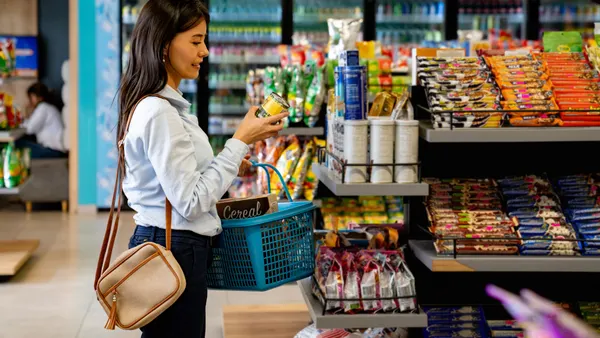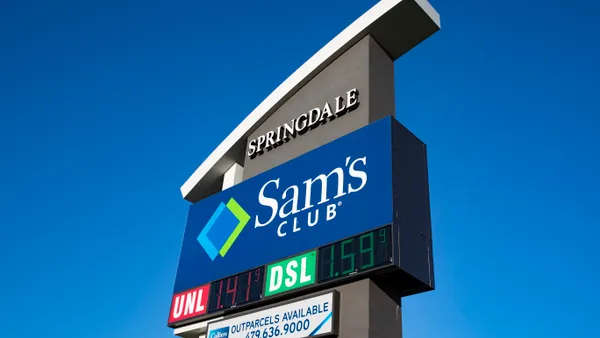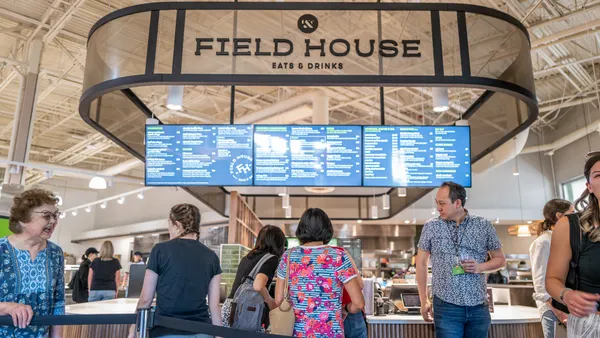When Mike Fogarty opened his first Choice Market in Denver nearly three years ago, delivery was on the menu. The hybrid store, which has a mix of grocery, convenience and fast casual restaurant operations, delivers meals on Postmates and Uber Eats. It also has plans to launch its own delivery fleet beginning next year, which will include Choice's entire product line of 3,000 to 4,000 items, he told Restaurant Dive.
This store model may sound niche, but it’s the direction major grocers are trending toward as they battle restaurants for the U.S. consumer's share of stomach.
Supermarkets like Hy-Vee and convenience stores like Wawa and Sheetz are offering more restaurant-quality meals for delivery on multiple third-party platforms. On delivery websites, these offerings can hold equal weight to restaurant offerings, and consumers may not even realize their next meal is actually coming from a retailer’s restaurant concept or prepared meals department.
"I think no doubt you're seeing a customer who maybe never ever would eat a meal out of a convenience store in the past starting to warm up to the idea of newer-age convenience stores offering fresh and healthy options," Fogarty said. "They are basically replacing the occasion of going to the restaurant. Similarly, groceries are taking some share away from restaurants."
Fogarty is gearing up to open a third Choice store and has plans to take his concept into new markets to challenge restaurants that are dipping their toes into delivery.
"We do inherently cross over multiple verticals so we compete for share against other fast casuals in Denver," he said.
This trend could spell big trouble for restaurants that are incrementally increasing sales through delivery and reaching more customers through the channel than they would have traditionally.
"If restaurants aren't paying attention to this they should probably start now because grocers are in a position to do some serious business [in delivery]," Frank Beard, GasBuddy analyst, told Restaurant Dive.
Fresh competition could be healthy for restaurants, and push them to take a closer look at their delivery menus to ensure their offerings are competitive. But for now, grocery's edge in prepared food could be strong enough to poach diners from traditional foodservice if they master the delivery piece.
Why grocers are growing competition for restaurants
Grocery stores are trying to draw customers back to their business as Americans trend toward eating out rather than cooking at home. One tactic is grab-and-go meal replacements, Gray Taylor, executive director of Conexxus, a tech nonprofit that focuses on the convenience store and petroleum market, told Restaurant Dive.
Others have turned to prepared meal delivery as an additional way to reach more customers. Hy-Vee is offering delivery from six of its Market Grille locations in Des Moines while Wegmans and Publix partnered with DoorDash. But while prepared meal delivery is still in its nascent stages, grocery and convenience stores may have a slight delivery advantage over restaurants because their prepared food is often designed for travel, whereas restaurants need to figure out how to make a steak portable and still be the same quality as when it just left the kitchen, Taylor said.
Choice Markets, for example, developed a menu based on a fast casual restaurant that offers buildable bowls, salads, sandwiches, coffee and smoothies that can travel better than other things like fast food items, Fogarty said.
With grocery also offering raw food delivery, it can create a way for consumers to order meals for almost no additional delivery fee, Taylor said. Comparatively, standalone restaurants have been increasing menu prices alongside standard delivery fees to make the service profitable, he said. Noodles & Company charges a 10% premium for delivery, and The Habit Burger added a 25% upcharge for delivery when it launched the service in 2018.
Grocery stores also have an entire kitchen of food at their disposal, Beard said. While restaurants have a limited menu depending on their format, grocery stores sit on 40,000 to 60,000 square feet full of food of all kinds, he said.
"Grocers can really support their [in-store] restaurants in a way that other restaurants may not be supported," Beard said.
It's not just grocery stores that are getting into prepared meal delivery, either. Convenience stores are adding delivery and some are even offering catering menus, Beard said. Many c-stores have added a QSR element that is on par or better than local QSR competitors, Beard said. Wawa's loyal customer base often comes in for its popular hoagies, he said. To innovate, the company tries out new items in its test kitchen and sensory lab. The chain also caters and offers delivery, he said. Circle K and Kwik Trip also are getting into delivery, he said. 7-Eleven also is bulking up its delivery options, adding location-based delivery in June and rolling out voice-automated ordering in November.
These retailers also have the option of delivering alcohol where legally permitted, which is an additional perk for consumers that don't want to order from four different providers to get everything they need, Beard said. C-stores carry items like cigarettes and snack foods too, which can be easily added to a hot meal delivery order, Taylor said.
Choice Markets can compete with fast casuals in the Denver area because of its menu of healthy items, but it also benefits from its ability to offer local grocery items and convenience store snacks, Fogarty said.
Fogarty will lean heavily on the store's ability to offer thousands of items when it launches self-delivery with its third location. This intermodal format will act as an e-commerce last-mile hub with a drive-thru for online pickups and deliveries, and will offer supercharging stations, scooter share and fuel. Deliveries are expected to be completed within 45 minutes, he said. The company also has plans to open locations in nearby Aurora and Boulder, Colorado, and could eventually take the concept into new markets.
"I think on-demand and convenient is really quintessential to today's consumer," Fogarty said. "They want things now and they want not just typical CPG retail stuff that they can find at 7-Eleven."
Competing with restaurants will be tough
Even with the additional competition, restaurants still have several assets in their favor. They possess a better understanding of restaurant operations, which grocery stores or convenience stores may lack, Beard said. That is particularly apparent in convenience stores that suddenly have food service and struggle with understanding how complicated running an eatery can be, Beard said.
Retailers also have to keep a close eye on how food is being delivered. Domino's, for example, has already figured out how to address transportation issues. It rolled out delivery insurance in the fall, giving customers the option to report a pizza that didn’t arrive in impeccable condition to receive a replacement pizza at a later date. It also plans to launch GPS tracking so that customers can track their orders.
Packaging can also make or break food quality and retailers should consider if its packaging adds condensation, allows food to slosh around or leaks into the bag, among other aspects, Beard said. Packaging is a particular struggle for delivery operations, and even McDonald's has been looking at options to better deliver its food.
"You have to get everything right consistently all the time," he said.
Grocery stores may also struggle with delivery because prepared food could be at different stations, or measured by weight or within salad bars, which makes these items difficult to display digitally, Fogarty said.
"If you're a grocery and the sky's the limit as far as what you can sell in a restaurant, you could potentially run the risk of creating a menu that is large and has everything on there, but doesn't appeal to any one niche and feels bland."

Frank Beard
Analyst, Gasbuddy
And though grocery stores have a huge pantry of products at their disposal, this could also be a pitfall.
"If you're a grocery and the sky's the limit as far as what you can sell in a restaurant, you could potentially run the risk of creating a menu that is large and has everything on there, but doesn't appeal to any one niche and feels bland," Beard said.
Restaurants won't be able to coast, though. Aggregator marketplaces emphasize menu items over branding, meaning grocery and convenience store options will hold equal weight, Beard said.
"These [restaurant] brands can't rest on their past success and what they think is a meaningful brand when consumers know they can get on Uber Eats and get high quality things in 30 minutes," Beard said.
Beard anticipates the additional competition to have an impact on restaurants similar to how Airbnb impacted the hospitality segment. When Airbnb entered the market, some hotel brands weren't putting much thought in terms of the room, bar or lobby experience. Now they have been coming up with boutique concepts that can compete with Airbnb, Beard said.
The transition is already happening in the fast casual space with some chef-driven concepts and other brands — like Mixt in San Francisco and Sweetgreen in Washington, D.C. — that focus on locally sourced, sustainable and fresh ingredients, said Beard.
Other brands have been trying to add more to the delivery experience. Chuck E. Cheese offers party packs that include decorations and party supplies while Chili's launched a delivery promotion in November where diners can get custom merchandise, from a candle that smells like baby back ribs to a trivia card game.
At the same time, grocery stores could end up leaving delivery altogether in a few years or less if revenue just doesn't prove to be significant, and just focus on their sweet spots, which is meal replacements and weekly grocery shopping, Taylor said.
"The strong restaurant offers are going to be very tough to beat," Taylor said.
Delivery isn't likely going to make or break a QSR's business plan, either, especially with 60% to 70% of business going through the drive-thru window, Beard said. McDonald's and many others have been investing in improving the customer experience at the drive-thru.
"You're reaching people when they are in transit from point a to point b," Beard said. "As far as I can tell, delivery doesn't seem to be able to do that very well."
Choice Markets' hybrid model could also provide some hints as to what food delivery will look like. Restaurants are already learning from grocery and convenience stores and launching hybrid models as well. Eataly, which includes restaurants and a grocery store, has expanded its locations. This concept plays upon both elements, meaning diners who enjoy a dish at the restaurant can get the ingredients from the grocery store. Other restaurants may start offering retail items like a specialty sauce customers can take with them and options for grab and go, Fogarty said.
"You'll continue to see restaurants become grocerants and vice versa," Fogarty said. "It's going to be a very interesting next few years here."












